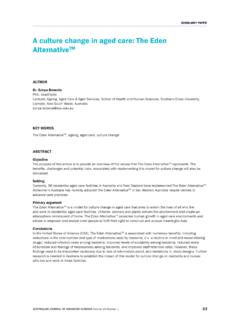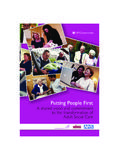Transcription of CHAPTER 5 Abuse of the elderly - who.int
1 CHAPTER 5 Abuse of the elderlyBackgroundThe Abuse of older people by family members datesback to ancient times. Until the advent of initiativesto address child Abuse and domestic violence in thelast quarter of the 20th century, it remained aprivate matter, hidden from public view. Initiallyseen as a social welfare issue and subsequently aproblem of ageing, Abuse of the elderly , like otherforms of family violence, has developed into apublic health and criminal justice concern. Thesetwo fields public health and criminal justice have therefore dictated to a large extent how abuseof the elderly is viewed, how it is analysed, andhow it is dealt with. This CHAPTER focuses on abuseof older people by family members or othersknown to them, either in their homes or inresidential or other institutional settings.
2 It doesnot cover other types of violence that may bedirected at older people, such as violence bystrangers, street crime, gang warfare or of older people referred to as elder Abuse was first described in Britishscientific journals in 1975 under the term grannybattering (1, 2). As a social and political issue,though, it was the United States Congress that firstseized on the problem, followed later by research-ers and practitioners. During the 1980s scientificresearch and government actions were reportedfrom Australia, Canada, China (Hong Kong SAR),Norway, Sweden and the United States, and in thefollowing decade from Argentina, Brazil, Chile,India,Israel,Japan,SouthAfrica,the UnitedKingdom and other European countries.
3 Althoughelder Abuse was first identified in developedcountries, where most of the existing research hasbeen conducted, anecdotal evidence and otherreports from some developing countries haveshown that it is a universal phenomenon. Thatelder Abuse is being taken far more seriously nowreflects the growing worldwide concern abouthuman rights and gender equality, as well as aboutdomestic violence and population older age begins is not preciselydefined, which makes comparisons between stu-dies and between countries difficult. In Westernsocieties, the onset of older age is usuallyconsidered to coincide with the age of retirement,at 60 or 65 years of age. In most developingcountries, however, this socially constructed con-cept based on retirement age has little more significance in these countries are the rolesassigned to people in their lifetime.
4 Old age is thusregarded as that time of life when people, becauseof physical decline, can no longer carry out theirfamily or work over the mistreatment of older peoplehas been heightened by the realization that in thecoming decades, in both developed and developingcountries, there will be a dramatic increase in thepopulation in the older age segment what inFrench is termed le troisie`me a ge (the third age).It is predicted that by the year 2025, the globalpopulation of those aged 60 years and older willmore than double, from 542 million in 1995 toabout billion (see Figure ). The total numberof older people living in developing countries willalso more than double by 2025, reaching 850million (3) 12% of the overall population of thedeveloping world though in some countries,including Colombia, Indonesia, Kenya and Thai-land, the increase is expected to be more thanfourfold.
5 Throughout the world, 1 million peopleFIGURE globalpopulationaged60yearsand older, 1995--2025 Source: United Nations Population Division, 5. Abuse OF THE the age of 60 years every month, 80% ofwhom are in the developing outlive men in nearly all countries ofthe world, rich and poor (3). This gender gap is,however, considerably narrower in developingcountries, mainly because of higher rates ofmaternal mortality and,in recent years, alsobecause of the AIDS demographic changes are taking place indeveloping countries alongside increasing mobilityand changing family structures. Industrialization iseroding long-standing patterns of interdependencebetween the generations of a family, often resultingin material and emotional hardship for the family and community networks in manydeveloping countries that had formerly providedsupport to the older generation have been wea-kened, and often destroyed, by rapid social andeconomic change.
6 The AIDS pandemic is alsosignificantly affecting the lives of older people. Inmany parts of sub-Saharan Africa, for instance,children are being orphaned in large numbers astheir parents die from the disease. Older peoplewho had anticipated support from their children inold age are finding themselves to be the maincaregivers and without a family to help them in 30% of the world s elderly are covered bypension schemes. In Eastern Europe and thecountries of the former Soviet Union, for instance,as a result of the changes from planned to marketeconomies, many older people have been leftwithout a retirement income and the health andwelfare services that were provided by the formercommunist regimes. In the economies of bothdeveloped and developing countries, structuralinequalities have often been the cause among thegeneral population of low wages, high unemploy-ment, poor health services, lack of educationalopportunities and discrimination against women all of which have tended to make the elderly poorerand more people in developing countries still face asignificant risk from communicable diseases.
7 As lifeexpectancy increases in these countries, the elderlywill be subject to the same long-term, largelyincurable and often disabling diseases associatedwith old age that are currently most prevalent indeveloped countries. They will also face environ-mental dangers and the likelihood of violence intheir societies. Nevertheless, advances in medicalscience and in social welfare will ensure that manyolder people will enjoy longer periods of disability-free old age. Diseases will be avoided or theirimpact lessened through better health care strate-gies. The resulting large number of older peoplewill be a boon for society, constituting a greatreservoir of experience and is elder Abuse defined?It is generally agreed that Abuse of older people iseither an act of commission or of omission (inwhich case it is usually described as neglect ), andthat it may be either intentional or Abuse may be of a physical nature, it may bepsychological (involving emotional or verbalaggression), or it may involve financial or othermaterial maltreatment.
8 Regardless of the type ofabuse, it will certainly result in unnecessarysuffering, injury or pain, the loss or violation ofhuman rights, and a decreased quality of life for theolder person (4). Whether the behaviour is termedabusive, neglectful or exploitative will probablydepend on how frequently the mistreatmentoccurs, its duration, severity and consequences,and above all, the cultural context. Among theNavajo people in the United States, for instance,what had appeared to an outside researcher to beeconomic exploitation by family members wasregarded instead by the tribal elders concerned astheir cultural duty, and indeed privilege, to sharematerial belongings with their families (5). OtherIndian tribes in the United States viewed elder abuseas a community problem rather than an individualone (6).
9 The definition developed by Action on ElderAbuse in the United Kingdom (7) and adopted bythe International Network for the Prevention of ElderAbuse states that: Elder Abuse is a single or repeatedact, or lack of appropriate action, occurring withinany relationship where there is an expectation oftrust which causes harm or distress to an REPORT ON VIOLENCE AND HEALTH person. Such Abuse is generally divided into thefollowing categories:.Physical Abuse the infliction of pain orinjury, physical coercion, or physical or drug-induced or emotional Abuse theinfliction of mental or material Abuse the illegal orimproper exploitation or use of funds orresources of the older Abuse non-consensual sexual contactof any kind with the older the refusal or failure to fulfil acaregiving obligation.
10 This may or may notinvolve a conscious and intentional attempt toinflict physical or emotional distress on theolder definition of elder Abuse has been heavilyinfluenced by the work done in Canada, the UnitedKingdom and the United States. Studies conductedin China (Hong Kong SAR), Finland, Greece, India,Ireland, Israel, Norway, Poland and South Africahave approached the topic in distinctly differentways (8). Norwegian researchers, for instance,identified Abuse with a triangle of violence thatincludes a victim, a perpetrator and others, who directly or indirectly observe the principalplayers. In countries such as China, that emphasizeharmony and respect within society, neglecting thecare of an older person is considered an act of elderabuse.















